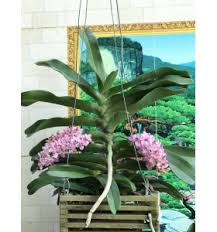# A Comprehensive Guide to Organic Cultivation of Da Châu Orchids

Da Châu orchids (*Rhynchostylis gigantea*) are renowned for their stunning beauty and delightful fragrance. As interest in sustainable gardening practices grows, more enthusiasts are turning to organic cultivation methods for these exquisite orchids. This guide will explore how to understand and implement organic practices for growing Da Châu orchids, ensuring they thrive in a natural and eco-friendly manner.
## Table of Contents
1. **Introduction**
– 1.1 Overview of Da Châu Orchids
– 1.2 Importance of Organic Cultivation
2. **Understanding Da Châu Orchids**
– 2.1 Botanical Characteristics
– 2.2 Natural Habitat
– 2.3 Growing Conditions
3. **Principles of Organic Cultivation**
– 3.1 What is Organic Cultivation?
– 3.2 Benefits of Organic Methods for Orchids
– 3.3 Organic Certification and Standards
4. **Preparing for Organic Cultivation**
– 4.1 Selecting Healthy Orchid Plants
– 4.2 Choosing the Right Potting Media
– 4.3 Understanding Nutrient Requirements
5. **Organic Growing Techniques**
– 5.1 Watering Practices
– 5.2 Fertilization Methods
– 5.3 Pest and Disease Management
– 5.4 Pruning and Maintenance
6. **Creating an Ideal Environment**
– 6.1 Light Requirements
– 6.2 Humidity and Temperature Control
– 6.3 Air Circulation
7. **Seasonal Care and Maintenance**
– 7.1 Spring and Summer Care
– 7.2 Fall and Winter Considerations
8. **Common Challenges in Organic Cultivation**
– 8.1 Dealing with Pests Naturally
– 8.2 Overcoming Nutrient Deficiencies
– 8.3 Managing Environmental Stress
9. **Innovative Practices in Organic Orchid Cultivation**
– 9.1 Companion Planting
– 9.2 Utilizing Organic Mulch
– 9.3 Incorporating Biostimulants
10. **Conclusion**
– 10.1 Encouragement for Organic Growers
– 10.2 Future of Organic Orchid Cultivation
—
## 1. Introduction
### 1.1 Overview of Da Châu Orchids
Da Châu orchids, scientifically known as *Rhynchostylis gigantea*, are epiphytic orchids native to Southeast Asia. Known for their striking clusters of flowers and fragrant aroma, these orchids are popular among horticulturists and collectors alike. With their vibrant colors ranging from white to purple, they can add a stunning visual element to any garden or home.
### 1.2 Importance of Organic Cultivation
Organic cultivation emphasizes sustainability, environmental health, and biodiversity. Growing Da Châu orchids organically not only promotes their health but also contributes to a healthier ecosystem. By avoiding synthetic fertilizers and pesticides, gardeners can enhance the natural beauty of these orchids while reducing environmental impact.
## 2. Understanding Da Châu Orchids
### 2.1 Botanical Characteristics
Da Châu orchids are characterized by their thick, leathery leaves and arching flower spikes, which can produce numerous fragrant blooms. The flowers can vary in size and color, making them a favorite choice for floral arrangements and gardens.
### 2.2 Natural Habitat
In their natural habitat, Da Châu orchids grow on trees in humid rainforests, thriving in bright but indirect sunlight. They are adapted to live in a symbiotic relationship with their environment, relying on the natural nutrients provided by decaying organic matter.
### 2.3 Growing Conditions
To successfully cultivate Da Châu orchids, it’s essential to replicate their natural conditions. They prefer warm temperatures, high humidity, and good air circulation. Understanding these conditions is key to nurturing healthy plants.
## 3. Principles of Organic Cultivation
### 3.1 What is Organic Cultivation?
Organic cultivation involves growing plants without the use of synthetic fertilizers, pesticides, or herbicides. It focuses on using natural inputs and sustainable practices that enhance the soil’s health and promote biodiversity.
### 3.2 Benefits of Organic Methods for Orchids
Organic methods offer numerous benefits for orchid cultivation, including:
– **Healthier Plants**: Organic cultivation promotes robust growth and disease resistance.
– **Environmental Sustainability**: Reduces chemical runoff and protects local ecosystems.
– **Enhanced Soil Quality**: Builds a rich and fertile soil ecosystem, benefiting all plants.
– **Flavor and Aroma**: Organic orchids often have enhanced fragrances and longevity in bloom.
### 3.3 Organic Certification and Standards
While many growers may practice organic methods without certification, obtaining organic certification can provide assurance to consumers about the quality and sustainability of your orchids. Different regions have varying standards, so it’s important to familiarize yourself with local organic regulations.
## 4. Preparing for Organic Cultivation
### 4.1 Selecting Healthy Orchid Plants
Start with healthy, disease-free plants when beginning your organic cultivation journey. Look for vigorous plants with strong roots, healthy foliage, and no signs of pests or diseases.
### 4.2 Choosing the Right Potting Media
Select a potting media that mimics the natural habitat of Da Châu orchids. An organic mix of bark, moss, and perlite or coconut coir can provide excellent drainage and aeration. Avoid standard potting soil, as it retains too much moisture for these epiphytic plants.
### 4.3 Understanding Nutrient Requirements
Da Châu orchids require specific nutrients to thrive. Understanding their nutrient needs will help you create an effective organic fertilization plan. Focus on providing essential macronutrients (nitrogen, phosphorus, potassium) and micronutrients (calcium, magnesium, iron) through natural amendments.
## 5. Organic Growing Techniques
### 5.1 Watering Practices
Watering is critical for the health of Da Châu orchids. Use room-temperature rainwater or distilled water to avoid chemicals present in tap water. Water thoroughly, allowing excess water to drain out, and let the potting media dry slightly between waterings to prevent root rot.
### 5.2 Fertilization Methods
In organic cultivation, fertilization can be achieved through:
– **Compost Tea**: Soak compost in water to create a nutrient-rich liquid fertilizer.
– **Organic Fertilizers**: Use natural options such as fish emulsion, seaweed extract, or bone meal.
– **Slow-Release Fertilizers**: Incorporate organic slow-release fertilizers into the potting media for sustained nutrient availability.
### 5.3 Pest and Disease Management
Managing pests and diseases organically is essential for healthy orchids. Employ the following strategies:
– **Natural Predators**: Introduce beneficial insects like ladybugs to control pest populations.
– **Neem Oil**: Use neem oil as a natural pesticide to deter pests and prevent fungal infections.
– **Companion Planting**: Plant companion plants that repel pests or attract beneficial insects.
### 5.4 Pruning and Maintenance
Regular pruning is important for maintaining the health of Da Châu orchids. Remove dead or yellowing leaves and spent flower spikes to encourage new growth. Ensure proper air circulation by spacing plants adequately and removing any debris that may accumulate.
## 6. Creating an Ideal Environment
### 6.1 Light Requirements
Da Châu orchids thrive in bright, indirect light. Position them near windows that receive filtered sunlight, avoiding direct exposure that can scorch the leaves. Consider using sheer curtains to diffuse sunlight.
### 6.2 Humidity and Temperature Control
Maintain high humidity levels (50-70%) for optimal growth. Use humidifiers, pebble trays filled with water, or misting to increase humidity around the orchids. Ideal temperatures range from 20°C to 30°C (68°F to 86°F), so monitor and adjust as necessary.
### 6.3 Air Circulation
Good air circulation is crucial to prevent fungal infections and promote healthy growth. Place fans in the vicinity or ensure proper spacing between plants to allow air to flow freely.
## 7. Seasonal Care and Maintenance
### 7.1 Spring and Summer Care
During the growing season, increase watering and fertilization frequency to support active growth. Monitor for pests and diseases, as warmer weather can lead to increased insect activity. Ensure that orchids receive enough light to promote flowering.
### 7.2 Fall and Winter Considerations
As temperatures drop, reduce watering and fertilization frequency. Ensure that orchids are protected from cold drafts and temperature fluctuations. This period may lead to dormancy, so adjust care accordingly.
## 8. Common Challenges in Organic Cultivation
### 8.1 Dealing with Pests Naturally
Organic pest control requires vigilance. Regularly inspect plants for signs of pests such as aphids, spider mites, or mealybugs. Employ natural remedies, such as insecticidal soap or homemade garlic sprays, to keep pests at bay.
### 8.2 Overcoming Nutrient Deficiencies
Monitor for signs of nutrient deficiencies, such as yellowing leaves or poor growth. Adjust your fertilization routine, incorporating organic amendments to address specific deficiencies. Regular soil testing can help identify nutrient imbalances.
### 8.3 Managing Environmental Stress
Environmental stressors like temperature fluctuations, humidity changes, and light levels can affect orchid health. Provide a stable environment, monitor conditions regularly, and adjust care practices based on seasonal changes.
## 9. Innovative Practices in Organic Orchid Cultivation
### 9.1 Companion Planting
Integrate companion plants that naturally repel pests or enhance the growing environment for orchids. Consider plants like marigolds or nasturtiums, which can deter aphids and other pests while adding beauty to your orchid display.
### 9.2 Utilizing Organic Mulch
Organic mulch can help maintain soil moisture and suppress weeds
. Use shredded bark, coconut coir, or straw around the base of your orchids to create a healthy growing environment while conserving moisture.
### 9.3 Incorporating Biostimulants
Biostimulants, such as seaweed extract or mycorrhizal fungi, can enhance nutrient uptake and promote healthy growth. Incorporate these natural amendments into your fertilization plan to boost the health of your orchids.
## 10. Conclusion
### 10.1 Encouragement for Organic Growers
Embracing organic cultivation methods for Da Châu orchids not only enhances their beauty but also promotes a healthier planet. By understanding the needs of these exquisite orchids and applying sustainable practices, you can enjoy vibrant blooms while contributing to environmental health.
### 10.2 Future of Organic Orchid Cultivation
As more gardeners turn to organic methods, the future of orchid cultivation looks promising. With a focus on sustainability and biodiversity, organic practices will continue to thrive, ensuring that the beauty of Da Châu orchids remains accessible for generations to come.
—
This comprehensive guide provides valuable insights and practical advice for anyone interested in organic cultivation of Da Châu orchids. By following these principles and techniques, you can nurture these beautiful plants sustainably, creating a thriving and eco-friendly gardening experience.

